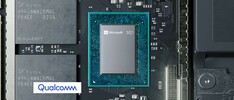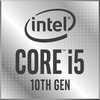Microsoft SQ1 vs Intel Core i5-1035G1 vs Intel Core i5-1034G1
Microsoft SQ1
► remove from comparison
The Microsoft SQ1 is a ARM based SoC for Windows tablets (Surface Pro X). It is based on the Snapdragon 8cx but with higher clocked CPU and GPU cores. The CPU cores clock with up to 3 GHz. The 4 Kryo 495 Gold cores are based on the ARM Cortex-A76 architecture (for performance) and clocked at up to 3 GHz (2.84 GHz for the 8cx) under load (no single core Turbo). The 4 Kryo 495 Silver cores are small ARM Cortex-A55 cores for power efficiency and clocked at 1.9 GHz (unverified) under load. The integrated X24 LTE modem supports up to 2 Gbps download speeds. Furthermore, the SoC integrates ac-Wifi and a dual-channel 32-bit 1866 MHz LPDDR4x memory controller.
The processor performance should be similar to a Intel Core i5 8th gen U-series (e.g. i5-8250U) according to Qualcomm. However, this is only the case for native ARM64 compiled Windows apps which are not that many (in mid 2019). 32 bit applications and games for AMD/Intel run in a rather slow emulation and 65 bit apps wont start at all.
The integrated Adreno 685 graphics card is a higher clocked version of the Adreno 680 in the Snapdragon 8cx. Microsoft claims 2 TFlops theoretical performance compared to the 1.8 for the Adreno 680 (+11%).
The chip is very power efficient as its produced at TSMC in the modern 7 process. Therefore, laptops using the Snapdragon 8cx can be passively cooled (no fan) and should not throttle under constant load.
Intel Core i5-1035G1
► remove from comparison
The Intel Core i5-1035G1 is a low-power, Ice Lake family processor (SoC) featuring 4 cores, 8 threads, 6 MB of L3 cache and the UHD G1 (32 EUs) iGPU. It saw the light of day in H2 2019. The chip is designed for use in highly portable laptops; its CPU cores run at 1.0 GHz to 3.6 GHz, with only 3.2 GHz achievable if all the cores are loaded.
Unlike the costlier Core i5-1035G4, the 1035G1 has the 32 EU UHD Graphics G1 iGPU at its disposal as opposed to the more powerful 48 EU Iris Plus G4; CPU cores run at a slightly lower clock rate in the case of the 1035G1, too.
Architecture & Features
Ice Lake family chips are powered by Sunny Cove CPU cores.The latter aim to do what Palm Cove cores (that we never really got a chance to get a taste of) were expected to do, delivering a double-digit IPC uplift over the venerable Skylake architecture thanks to a range of small improvements across the board including scheduler improvements, larger caches and buffers, and support for new instruction sets.
Thunderbolt 3 support is built right into the Core i5 (meaning the latter has several PCIe 3 lanes exclusive to Thunderbolt devices, reducing the number of additional components required for Thunderbolt to work) and so is Intel CNVi Wi-Fi 6 support (making it easier for Intel to sell its proprietary WLAN cards to laptop makers). The Core i5-1035G1 also has the DL Boost and GNA features for applications centered around machine learning.
The 4 GT/s bus is indicative of a consumer-grade chip, since CPUs for gaming laptops and portable workstations usually employ the faster 8 GT/s bus. RAM support is nothing to sneeze at, at up to DDR4-3200 or LPDDR4-3733. NVMe SSDs are supported, with data transfer rates limited to 3.9 GB/s (this is what four PCIe 3 lanes are good for). SATA drives and even eMMC chips are also natively supported here.
This is not a user-replaceable CPU, as it gets permanently soldered to the motherboard (BGA1526 socket interface).
OS support is limited to 64-bit Windows 10 and Windows 11, as well as many Linux distros.
Performance
The Core i5-1035G1 is a lower mid-range CPU, as of mid 2022. It is good for more than just the basics while being no match for true high-performers such as the mighty Core i7-10850H.
According to our in-house testing, the Core i5 delivers multi-thread performance that is similar to what the Core i7-10610U, the Core i7-1160G7 and the Ryzen 5 PRO 3500U have to offer. Your mileage may vary depending on how competent the cooling solution of your system is and how high the CPU power limits are.
The Lenovo IdeaPad 5 15IIL05 is among the fastest laptops featuring the 1035G1 that we have tested.
Graphics
The UHD Graphics G1 is based on Intel's Gen 11 architecture. The UHD Graphics runs at up to 1,050 MHz and has 32 EUs for fairly unimpressive performance; the Iris Plus G4 has 48 EUs while the Iris Plus G7 has 64 EUs, for reference. This iGPU will drive up to 3 monitors simultaneously and is DX12-compatible. The resolution options are capped at 5120 by 3200. There is no hardware AV1 codec support here, meaning such a video will be SW-decoded with rather low energy efficiency. The usual HEVC, AVC and VP9 codecs are supported, thankfully.
The UHD Graphics is significantly faster than the UHD Graphics 620, yet it's still not as good as a proper discrete graphics card would be. It will let one play certain games, F1 2020 included, provided one is content with the 720p resolution and low quality settings.
Power consumption
The Core i5-1035G1 has a default TDP (also known as the long-term Power Limit) of 15 W. Laptop makers are free to increase that value somewhat, with 25 W being the upper limit, or reduce it (values as low as 13 W are possible). Clock speeds and performance will change accordingly as a result. Either way, an active cooling solution will be required to dissipate the heat.
The chip is manufactured on Intel's second-generation 10 nm process (not "10 nm SuperFin" or "Intel 7") for average, as of late 2022, energy efficiency.
Intel Core i5-1034G1
► remove from comparison
The Intel Core i5-1034G1 is a power efficient quad-core SoC for laptops and Ultrabooks based on the Ice -Lake-U generation that was announced in Mai 2019 (Computex). It integrates four Sunnycove processor cores (8 threads thanks to HyperThreading) clocked at 0.8 (base) - 3.6 (single core Turbo) GHz. 2 cores can reach 3.6 GHz and all four 3.3 GHz using Turbo Boost. According to Intel the Sunnycove cores achieve 18% more IPCs (Instructions per Clock) and therefore the CPU performance should be similar to the higher clocked Whiskey-Lake predecessors (e.g. Core i5-8365U with up to 4.1 GHz).
The biggest improvement for Ice-Lake is the integrated Gen 11 graphics card called UHD Graphics G1. The Core i5-1034G1 integrates the smallest GPU, the UHD Graphics that features 32 of the 64 CUs and clocks at 300 - 1050? MHz. The faster variants include Iris Plus G4 and G7.
Other improvements for Ice Lake are the AI hardware acceleration and the partial integration of Thunderbolt and Wifi 6 in the chip. The integrated DDR4 memory controller supports modules with up to 3200 MHz (and LPDDDR4 3733).
The Core i5-1034G1 is produced in the improved 10nm+ process at Intel (2nd generation) that should offer a comparable performance to the 7nm process at TSMC. The TDP is specified at 15 Watts and therefore the CPU can be used in thin and light laptops (but usually with a fan). Intel offers a configurable TDP of 7.5 - 25 Watts for the partners resulting in significant performance differences (due to longer periods of Turbo Boost).
| Model | Microsoft SQ1 | Intel Core i5-1035G1 | Intel Core i5-1034G1 | ||||||||||||||||||||||||||||||||||||||||||||
| Series | Qualcomm Snapdragon | Intel Ice Lake | Intel Ice Lake | ||||||||||||||||||||||||||||||||||||||||||||
| Codename | Cortex-A76 / A55 (Kryo 495) | Ice Lake-U | Ice Lake U | ||||||||||||||||||||||||||||||||||||||||||||
| Series: Ice Lake Ice Lake U |
|
|
| ||||||||||||||||||||||||||||||||||||||||||||
| Clock | 3000 MHz | 1000 - 3600 MHz | 800 - 3600 MHz | ||||||||||||||||||||||||||||||||||||||||||||
| L3 Cache | 2 MB | 6 MB | 6 MB | ||||||||||||||||||||||||||||||||||||||||||||
| Cores / Threads | 8 / 8 | 4 / 8 | 4 / 8 | ||||||||||||||||||||||||||||||||||||||||||||
| Technology | 7 nm | 10 nm | 10 nm | ||||||||||||||||||||||||||||||||||||||||||||
| Features | X24 LTE Modem, Adreno 685 GPU | DDR4-3200/LPDDR4-3733 RAM, PCIe 3, 4 GT/s bus, DL Boost, GNA, MMX, SSE, SSE2, SSE3, SSSE3, SSE4.1, SSE4.2, AVX, AVX2, AVX-512, BMI2, ABM, FMA, ADX, VMX, SMEP, SMAP, EIST, TM1, TM2, Hyper-Threading, Turbo, SST, AES-NI, RDRAND, RDSEED, SHA, SGX | AVX512, DL Boost, Turbo Boost 2.0 | ||||||||||||||||||||||||||||||||||||||||||||
| iGPU | Qualcomm Adreno 685 | Intel UHD Graphics G1 (Ice Lake 32 EU) (300 - 1050 MHz) | Intel UHD Graphics G1 (Ice Lake 32 EU) (300 MHz) | ||||||||||||||||||||||||||||||||||||||||||||
| Architecture | ARM | x86 | x86 | ||||||||||||||||||||||||||||||||||||||||||||
| Announced | |||||||||||||||||||||||||||||||||||||||||||||||
| Manufacturer | www.microsoft.com | ark.intel.com | |||||||||||||||||||||||||||||||||||||||||||||
| L1 Cache | 192 KB | 192 KB | |||||||||||||||||||||||||||||||||||||||||||||
| L2 Cache | 2 MB | 2 MB | |||||||||||||||||||||||||||||||||||||||||||||
| TDP | 15 Watt | 15 Watt | |||||||||||||||||||||||||||||||||||||||||||||
| max. Temp. | 100 °C | ||||||||||||||||||||||||||||||||||||||||||||||
| Socket | BGA1526 |


 Deutsch
Deutsch English
English Español
Español Français
Français Italiano
Italiano Nederlands
Nederlands Polski
Polski Português
Português Русский
Русский Türkçe
Türkçe Svenska
Svenska Chinese
Chinese Magyar
Magyar
